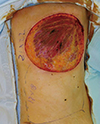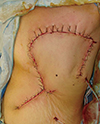Abstract
Many flaps have been described and are being used in the reconstruction of extensive tissue defects in the thoracic wall. The extended cutaneous thoracoabdominal flap, described in 2006, is an excellent option for chest wall reconstruction in patients with advanced breast cancer, being associated with a low morbidity rate and good functional results. The main disadvantage of this technique is the poor cosmetic outcome and the complete absence of a breast crease. We present the first case of a two-stage heterologous breast reconstruction after reconstruction using an extended cutaneous thoracoabdominal flap.
Many different surgical options are available for the reconstruction of extensive tissue defects in the thoracic wall, including the use of cutaneous, fasciocutaneous, and muscular flaps. A number of flaps have been described and are being used for the reconstruction of extensive tissue defects in the thoracic wall [1-5].
The extended cutaneous thoracoabdominal flap, described in 2006 [6], seems to be a valid option for chest wall reconstruction because of the large dimension of the flap and the low associated morbidity rate, especially in patients with a poor general condition, advanced tumor stage, and a history of radiotherapy.
However, the major disadvantage of this type of reconstruction, compared to the use of muscular and musculocutaneous flaps, is the inability to perform immediate breast reconstruction [7-9].
We present the first case of a two-stage tissue expander/implant breast reconstruction from our series of patients who had previously undergone reconstruction with an extended cutaneous thoracoabdominal flap.
In July 2008, a 44-year-old woman underwent extended modified radical mastectomy including only the pectoralis fascia with extensive skin paddle resection for advanced cancer of the left breast (Figure 1). Immediate chest wall reconstruction was achieved using an extended cutaneous thoracoabdominal flap, 18×20 cm in size, drawn on the homolateral abdominal wall, rotated clockwise in the left chest wall, and adapted to the defect (Figures 2, 3); no complications were recorded. The patient received adjuvant chemotherapy over a 6-month period.
After 2 years of uneventful follow-up, the patient required breast reconstruction. We planned two-stage implant breast reconstruction using a Natrelle 133-850 cc Full Height biodimensional tissue expander (Allergan Inc., Irvine, USA) placed in the subcutaneous plane under the flap through a 5-cm incision overlapping the previous scar on the anterior axillary line. The size of the expander implant was selected according to contralateral breast width, which was measured preoperatively. The inferior border of the expander was placed symmetrical to the contralateral side as planned preoperatively. The expander was then inflated with saline solution at weekly intervals postoperatively to achieve a total volume of 850 cc.
Four months after expansion, the second stage of the procedure was performed using a Natrelle 410 FF 740-cc anatomical permanent silicone cohesive gel implant (Allergan Inc.); a circumferential basal capsulotomy was performed and the inframammary fold was reconstructed, with the anterior leaf cranially advanced on the chest wall in a "slingshot" fashion. Contralateral augmentation mammaplasty was performed to achieve symmetry between breasts; two closed-suction drains were placed and removed after 6 days. The esthetic outcome was good, as assessed by a blinded expert using standardized patient photographs with frontal and bilateral oblique views, taken at the 1-year follow-up (Figure 4). Follow-up evaluations included total body computed tomography, ultrasonography of the reconstructed breast, and contralateral mammography of the healthy breast, which did not indicate recurrence.
Advanced tumor stage, radiotherapy complications in the surrounding tissue, and poor general conditions are critical issues to consider when choosing the best method for chest wall reconstruction. The extended cutaneous thoracoabdominal flap, as we described in 2006 [6], has proven to be an interesting option, especially in cases of bad prognosis or a poor general condition.
This flap allows coverage of large defects in a single-stage procedure at the expense of large scars and poor cosmetic results; in fact, is impossible to perform an immediate breast reconstruction when using this flap. This major disadvantage can be mitigated, once the prognosis and the patient's general condition have improved, by performing a simple heterologous breast reconstruction, as we demonstrated for the first time through this case report.
Our experience showed that the skin of the flap was of good quality and flexible, since it was not previously irradiated, and it allowed adequate tissue expansion, which persisted over time.
Moreover, the two-stage tissue expander/implant breast reconstruction was simple to perform, and no immediate or delayed complications were recorded. We decided to perform this procedure in order to achieve good symmetry between breasts, masking the esthetically displeasing new scars that occurred as a result of the thoracic reconstruction. The expander was placed so as to achieve good lower pole expansion, which was very useful in procuring enough skin to reconstruct the inframammary fold in the second stage and in establishing a natural lower pole appearance.
Moreover, in this specific patient, the thickness of the cutaneous flap allowed us to avoid pectoralis major detachment when placing the expander and then the definitive implant in the subcutaneous plane. The breast symmetry achieved was sound and stable at the 1-year follow-up; patient satisfaction, ascertained by a patient self-assessment questionnaire, was favorable, with a good, esthetic breast shape. We believe that a high-quality breast reconstruction can be achieved by using a two-stage tissue expander/implant procedure in patients who, for local or systemic reasons, cannot undergo immediate reconstruction.
Figures and Tables
References
1. Mansour KA, Thourani VH, Losken A, Reeves JG, Miller JI Jr, Carlson GW, et al. Chest wall resections and reconstruction: a 25-year experience. Ann Thorac Surg. 2002; 73:1720–1725.

2. Chagpar A, Langstein HN, Kronowitz SJ, Singletary SE, Ross MI, Buchholz TA, et al. Treatment and outcome of patients with chest wall recurrence after mastectomy and breast reconstruction. Am J Surg. 2004; 187:164–169.

3. Papadopoulos O, Georgiou P, Christopoulos A, Tsakoniatis N. Chest wall reconstruction. Ann Plast Surg. 2002; 48:105–107.

4. Chang RR, Mehrara BJ, Hu QY, Disa JJ, Cordeiro PG. Reconstruction of complex oncologic chest wall defects: a 10-year experience. Ann Plast Surg. 2004; 52:471–479.
5. Losken A, Thourani VH, Carlson GW, Jones GE, Culbertson JH, Miller JI, et al. A reconstructive algorithm for plastic surgery following extensive chest wall resection. Br J Plast Surg. 2004; 57:295–302.

6. Persichetti P, Tenna S, Cagli B, Scuderi N. Extended cutaneous 'thoracoabdominal' flap for large chest wall reconstruction. Ann Plast Surg. 2006; 57:177–183.

7. Mayo JL, Dupin C, St Hilaire H. Outcomes in autologous breast reconstruction. J Am Coll Surg. 2013; 217:172–174.

8. Fischer JP, Nelson JA, Cleveland E, Sieber B, Rohrbach JI, Serletti JM, et al. Breast reconstruction modality outcome study: a comparison of expander/implants and free flaps in select patients. Plast Reconstr Surg. 2013; 131:928–934.




 PDF
PDF ePub
ePub Citation
Citation Print
Print






 XML Download
XML Download